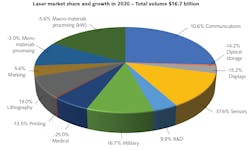2020 was a difficult year for the global economy, but laser markets did surprisingly well. Allen Nogee, President of Laser Markets Research, said that there are at least two different reasons for this resilience in laser markets, as noted in his annual review and forecast of the worldwide laser market. First, lasers are often built into capital goods, and such investments are not made or canceled on short notice. The second reason was the relatively fast recovery of the most important market for lasers and laser systems—China.
This logic has been reflected by global and national statistics. The GDP of the U.S. fell 3.6% in 2020; in Europe, it went down 7.4%; while in China, it grew 2.3%. At the same time, the global laser market grew at a remarkable pace of 8% to $16.5 billion (see figure).
While the uncertainty of the pandemic remains, Nogee presented an optimistic outlook for 2021. On the macro-economic side, he expects above-average growth in the U.S. (3.5%), Europe (3.6%), and China (7.9%). In fact, 2021 could show the highest growth rate in these regions in more than three years. Similarly, the laser market would expand by 10.4% to $18.2 billion in 2021.
When looking at the details of the different market segments, Nogee found substantial differences. Lasers for material processing, for example, showed a moderate growth of 3.5% to $5.2 billion in 2020. This segment experiences a strong pressure on unit prices while sales numbers increase. Asked about the ultrashort-pulse laser market, he saw demand increasing, while the total market size remained at about $600 million for several years.
The segment of lasers in communication equipment did much better, with an increase of 10.6% to $4.17 billion. This strength was mainly caused by China’s economic recovery and the transition to home offices and home schooling.
On the other side of the scale was the market for medical lasers, which shrank by 25% to $935 million. Dental laser sales dropped 29%, which might be connected to infection risks related to laser dental procedures. As opposed to medical laser markets, lasers for defense applications were not much impacted by COVID-19. There, attention is focused on directed energy weapons to defeat drones or small ships in a range of 1 to 3 miles. This segment grew 16% to $1.635 billion.
The semiconductor market had a very strong 2020, and, accordingly, laser systems sold to this market showed solid growth. Excimer lasers and big CO2 lasers benefited from this boom and they will continue to do so. The revenue for lasers for lithography systems improved by 19% to $1.275 billion, which is based on a 7.3% growth in the semiconductor industry, after a 12% decline in 2019.
With the rising popularity of optical sensing systems in smartphones, the laser market for sensing applications has seen a steep increase. Sensing lasers are mainly edge-emitting lasers and vertical-cavity surface-emitting lasers (VCSELs); their market expanded by an impressive 37.6% in 2020 to $ 2.078 billion. Civilian lidar and advanced driver-assistance systems (ADAS) made up only 9.3% of this market. Revenue from this subsector is expected to increase slowly, when first lidar systems enter the market in 2022 and beyond.
Lasers for smartphone devices made up 59% of the revenue in total laser sensing. Both face recognition and lidar have driven VCSEL sales to ever-new heights. Prospects in this field have led to a wave of mergers and acquisitions: Lumentum bought Oclaro in 2018, and TriLumina in 2020; II-VI purchased Finisar in 2018; and Trumpf acquired Philips Photonics in 2019, for its remarkable VCSEL program.
In summary, Allen Nogee found 2020 to be “not so bad for the laser industry.” For the ongoing year, he expects growth in almost all segments to pre-COVID levels or even some substantial growth beyond the levels of 2019 and 2020. If COVID does not cause a further slowdown in manufacturing, the global laser market may grow to remarkable $18.2 billion (see table).A final version of the data will be published in the annual report “The Worldwide Market for Lasers: Review and Forecast” by Laser Focus World later this year (see store.laserfocusworld.com). Participants in the Seminar are entitled to a discount on the full report.
CONTINUE READING >>>

Andreas Thoss | Contributing Editor, Germany
Andreas Thoss is the Managing Director of THOSS Media (Berlin) and has many years of experience in photonics-related research, publishing, marketing, and public relations. He worked with John Wiley & Sons until 2010, when he founded THOSS Media. In 2012, he founded the scientific journal Advanced Optical Technologies. His university research focused on ultrashort and ultra-intense laser pulses, and he holds several patents.

